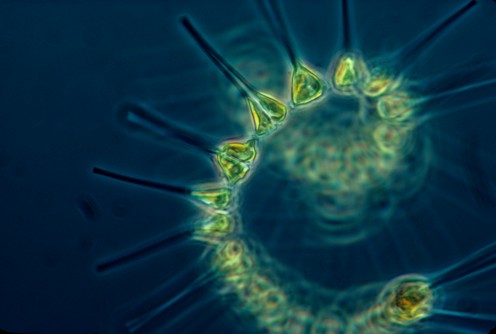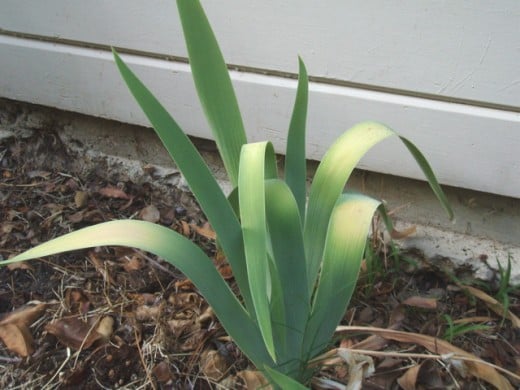The Role of Photosynthesis in a Sustainable Atmosphere

The human population is expanding like crazy, taking more and more oxygen out of the air as we breathe to stay alive. Cattle and hogs and chickens and all the other meats we cultivate are also multiplying, breathing more, taking oxygen out of the air in increasing amounts. How is it that there's still oxygen left? Something must be sustaining the atmosphere, or we'd all be dead by now.
A sustainable atmosphere is one where oxygen and carbon dioxide (C02) are in balance with each other—and with nitrogen and trace gases—where these gases are replenished naturally, so they continue to fuel life on earth long term.
We animals breathe oxygen produced by the plant kingdom (plants/trees/seaweeds). The plant kingdom breathes CO2 produced by the animal kingdom. In other words, as long as there are enough plants to counterbalance the human/animal population, we should have enough oxygen to stay alive for awhile.
The balance on the plant side is maintained by a process called photosynthesis. This article explores that process.
Basic Composition of Air

Earth's Atmosphere
The atmosphere of the earth is made up of layers of slightly different component mixtures of air. The layers serve to protect us from the elements of space, to balance the temperature of the earth and, in its closest layer, provide living things with gases we need to survive.
The graph at the right shows the basic composition of the air we breathe - from the layer that lies closest to the surface of the earth - the troposphere. There are five main gases, supported by several trace components of other gases. The main one, by far, is nitrogen. 78% of the air is nitrogen. Only 21% is oxygen. Argon comes next at 0.93%, then CO2 at .04%. Water vapor is the other main component (0.25%).
When we breathe, we take in all of these components, extract some of the oxygen to use, add some carbon dioxide we don't need, and breathe it out. So the air we breathe out is the same as what we breathed in, but with less oxygen and more carbon dioxide.
With plants, the opposite is true. They extract carbon dioxide for photosynthesis and throw away extra oxygen into the atmosphere. So we (animals and fish) are half and they (plants and plankton) are the other half of the oxygen cycle.
Plants on land produce just over 50% of the oxygen that replenishes our atmosphere today, while ocean phytoplankton produces almost all of the rest. A relatively minute amount is released from the weathering of rocks, like limestone.
Phytoplankton Producers of Oxygen

". . . the life of the planet began the long, slow process of modulating and regulating the physical conditions of the planet. The oxygen in today's atmosphere is almost entirely the result of photosynthetic living, which had its start with the appearance of blue-green algae among the microorganisms."
-Lewis Thomas
Phytoplankton Started the Production of Oxygen
Phytoplankton were the earth's earliest plant oxygen producers, able to live in conditions that were toxic to other plants. Through photosynthesis, blue green algae and other types of phytoplankton eventually reduced CO2 in the primitive atmosphere and built up the oxygen that animals and fish now breathe.
Phytoplankton bloom in coastal areas, where winds churn the water and pull up nutrients from the ocean's depths. When they take over a coastline, it's often a signal that there is excessive agricultural runoff in that area, with an over-abundance of nitrogen and CO2 and low amounts of oxygen in the water. The phytoplankton are the ocean's way of cleansing the water and putting it back into balance.
In the process, they produce a ton of oxygen, via photosynthesis, which is great for the atmosphere. How do they do that? What is photosynthesis?
Definition of Photosynthesis
Photosynthesis is a compound word that tells how it works. "Photo" means light. "Synthesis" means to put together. Light hitting a phototroph (organism that carries out photosynthesis) triggers a chemical reaction that breaks apart air and water molecules, then puts the parts together in a different way to make food for the phototroph, along with leftover oxygen.
Plants "eat" the glucose they produce from photosynthesis. This is what gives them energy to keep growing and keep photosynthesizing. They combine it with certain minerals and trace elements sucked up with water through their root system to build their plant structure, including leaves, flowers, and fruits/seeds. Breathing is merely a chemical exchange with the air.
The Earth Breathing
To breathe, the plant absorbs carbon dioxide through cells under its leaves, uses it to make food and, since it doesn't need the leftover oxygen (O2), lets it go into the air.
Plants primarily breathe the opposite from animals like us. We use up oxygen when we breathe and let go of carbon dioxide. Plants use up carbon dioxide and let go of oxygen. Old trees produce the greatest amount of oxygen, which is why old growth forests and jungles are called the "lungs of the earth," and why it's so important to keep them intact.

The Photosynthesis Equation
It's important for us to understand the process of photosynthesis, so we don't inadvertently kill off our breathing "partners," so to speak.
The chemical reaction that changes carbon dioxide and water into plant food and oxygen looks like this: 6CO2 + 6H2O --> C6H12O6 + 6O2
Here's how that reads: 6 molecules of carbon dioxide + 6 molecules of water recombine to make 1 energy molecule + 6 oxygen molecules. The plant stores the energy molecule for future "eating" and discards the oxygen molecules into the air. This whole process is initially triggered by light.
Components of Photosynthesis
Click thumbnail to view full-size

Stages of Photosynthesis
From the beginning to the end, here is how the process works:
-
The plant absorbs carbon dioxide through its "stomata" (pores in the leaves).
-
When light hits the leaves, it triggers chlorophyll and its helpers to release electrons. Chlorophyll is made by the plant. Like blood, it flows up a plant's xylem (veins) and into its leaves and their chloroplasts. This is the active component that recombines the water and carbon dioxide.
-
The plant uses the electrons made by the chloroplasts to break up water molecules, separating them into 4 hydrogen atoms and 2 oxygen atoms.
-
The hydrogen atoms join together with the carbon dioxide in the leaves to make a complex sugar molecule, called glucose, which the plant stores for future use.
-
Oxygen molecules are left over and the plant "breathes" them out into the atmosphere.
Each type of plant requires a different combination of water, air, sunlight, and chlorophyll to photosynthesize the amount of energy it requires. When that balance is right for the plant it will look healthy, vibrant, and strong. This is why it's important for plants to be growing in their natural habitat. All the resources they need are there—not too little, not too much.
Balance of Water & Sun
Click thumbnail to view full-size



Problems With Photosynthesis
When a plant is out of place or doesn't have the right balance of resources, it will be weak and will attract insects that look for weak plants to feed from. When you see insects attacking a plant, you pretty much know that something is wrong with the plant. Either it's not getting enough of something or it's getting too much.
When one component is too low you can adjust whatever is missing to help the plant grow strong again. Here is what happens to a plant when something is missing:
-
With too little sunlight, only some of the chlorophyll will be triggered to produce energy. There won't be enough energy and the plant will look spindly and weak.
-
With too little water, there won't be enough energy to keep all the leaves alive, nor will there be enough turgidity (inside pressure) to keep the stems full and upright. Leaves will fall off, the edges of the remaining leaves will be brown, and eventually the stems will shrivel up.
- With too little CO2, the plant will suffocate and wither. This is seldom the case, since most plants have access to air and there is plenty of CO2 in today's air.
- With too little chlorophyll, the plant will yellow and die, since it can't synthesize enough energy to live on.
When one component is too high insects will attack too. Too much of a component can be just as debilitating to a plant as too little, and insects love sick plants. Here is what happens to a plant when it's flooded with too much of a good thing:
-
With too much sun, the plant will burn up trying to make too much energy for itself, at the same time having not enough water to cool off.
-
Too much water will rot the roots, so they can't draw enough water up into the leaves where photosynthesis takes place.
- Carbon dioxide increases heat, too much of which causes the same problem as too much sun. Initially the plant will thrive—as carbon dioxide increases, so does photosynthesis. But too much heat from carbon dioxide will cause a plant to wilt, since it can't use the same water to both cool the plant and make food.
- Too much chlorophyll, produced when people add too much artificial nitrogen to the soil, can cause a plant to overgrow. It creates leaves but no flowers or seeds, so the plant doesn't reproduce.
Kelp Forest

Each type of plant has its own sun/water balance requirements and its own needs for survival. Each one thrives in a different way in its own environment, which nature once provided, but which humans have altered. Some plants even photosynthesize in a different way (but they are a small minority).
Most plants follow the process above, creating their own food via photosynthesis, and supplying the air with leftover oxygen. That "leftover" oxygen lets us breathe, and this is why it's so important for us to be aware of how human activities affect plant life on the planet.
In a real sense, plants keep us alive, especially old growth trees which produce more oxygen than any other plant. When we kill off the forests and jungles, we kill off ourselves. When we kill off seaweed and plankton in the ocean, we do the same.
Not only do we need to reduce our excess carbon production, we also need to stop whatever we're doing that kills off plant life, in order to keep ourselves alive.
For more information:
- What are Phytoplankton? | NASA
Microscopic plant-like organisms called phytoplankton are the base of the marine food web, and they play a key role in removing carbon dioxide from the air. - Trees & Shrubs In a Sustainable Landscape
What exactly is a tree? What does it do? Why is it built the way it is? This article shows why it's important to choose trees for your landscape that are native to that locale.














